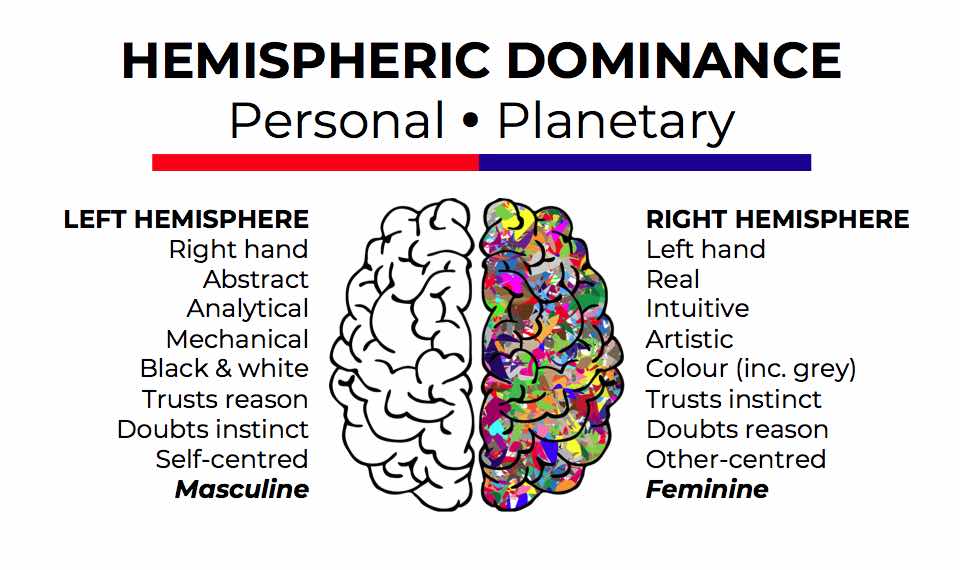3 Effects of left-brain hemispheric dominance
- 7 February 2024
- Posted by: Michael H Hallett
- Category: Emotional principles ,

While effects of mental health in general and generational trauma in particular attract increasing attention, one piece of the wellness puzzle remains under-recognised—left-brain hemispheric dominance.
I’d go as far as saying that hemispheric dominance is the bad boy of the mental health brat pack. It will be one of the last (though not the last) pieces of the puzzle to be recognised and addressed on a wide scale, and will likely be ignored, dismissed, and disparaged for some time to come.
One of the reasons for this is that hemispheric dominance is self-cancelling. One of its effects is to conceal its own existence. But what other effects does it have?
What is hemispheric dominance?
Firstly, a quick recap of what it is so we can better understand its effects.
Neuropsychologist Roger W. Sperry first proposed the theory of hemispheric dominance in 1960. He later won the Nobel Prize for this work. In my own simplistic terms, it boils down to three interlocking principles:
- Brain functions are specialised between the left and right hemispheres.
- Intellectual processing occurs in the left brain.
- Most people are left-brain dominant.

Hemispheric dominance is one of the key components of what I call the Patriarchal Operating System—the acquisitive, consumptive, destructive psychological model crippling humanity and the earth.
It’s also known as hemispheric lateralization. It explains how we ended up with a society that is highly intelligent yet at the same time environmentally destructive and woefully lacking in common sense and wellbeing.
For more information, including its origins and science’s later rejection of the concept, please read What is hemispheric dominance?
Effect #1 – division
The first, and primary effect of hemispheric dominance is division.
This is missing from the graphic above—the right brain is additive; the left brain is divisive. This division is the source of our polarised worldview—left and right, good and bad, us and them, love and hate.
It’s important to realise that the perception of division comes first, and then comes the real-world evidence to validate the perception. Unaware of our own hemispheric dominance, we fail to recognise the pre-eminence of this unconscious perception.
Say we meet someone new. We unconsciously judge them (on appearance, dress, manner, race, sexuality, etc.) as good or bad. Let’s say we form an unconscious negative perception. The person picks up on this and acts defensively. We then form a conscious perception of them as untrustworthy, which we believe arose from their demeanour, not our perception.
Society is riddled with situations where this unconscious bias has determined access to jobs, education, medical or legal care, etc.
The perception of division creates disharmony in our inner and outer worlds, just as the perception of unity (“All you need is love”) creates harmony.
Yet this division isn’t entirely negative. The divisive, scalpel-like quality of hemispheric dominance lies behind the rise of modern science and all its technological benefits.
Effect #2 – short-termism
A secondary effect of hemispheric dominance is a short-term, immediate gain mentality.
Disconnected from the feminine right brain with its focus on nurturing, community, and sustainability, the left brain sees only immediate gains or losses (survival mentality). It struggles to recognise the negative consequences of its actions.
Virtually every technological innovation of mankind’s has had a destructive effect on the natural, feminine world. Burning down forests for fuel. Coal, oil, and nuclear power. Planes, trains, and automobiles. Barbed wire. Asbestos, thalidomide, opiates.
Short-termism crystallises the mind for immediate decision-making, yielding instant results. Humanity has been living with the growing consequences of hemispheric dominance for the last six millennia.
Effect #3 – taboos
A third effect of hemispheric dominance stems from its doubt, distrust, and fear of instincts.
Instincts and instinctive behaviour don’t compartmentalise easily into the catalogued, orderly world the left brain craves. Instinctive behaviour is messy.
Consequently, the left-brain walls off the things it fears and detests—uncontrolled emotions, instinctive wisdom, unregulated sexuality. In hemispheric dominant societies, these aspects of life—the right-brain, feminine aspects—are suppressed and repressed as taboos.
Overcoming hemispheric dominance and its ills requires a conscious shift out of divisive thinking into a non-judgmental state where heart and mind are in balance.
In today’s world we’re seeing a huge resurgence of feminine values. As part of that resurgence, hemispheric dominance must inevitably come under scrutiny.
Photo by Giulia May on Unsplash
